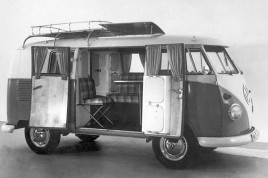When Jerry Garcia passed away in 1995, Volkswagen remembered the Grateful Dead frontman by running an ad featuring a VW Microbus with a tear streaming from one headlight. It was an epochal moment when two counterculture symbols came together in tender recognition of their influence on mainstream society. In the 1960s, both Garcia and the Microbus came to represent a growing angst in America about the country’s role as a nuclear superpower and its reliance on commercialism to feed a voracious appetite for more, more, more. A certain segment of society decided to “turn on, tune in and drop out,” as Harvard psychologist Timothy Leary put it, by focusing on the psychedelic rock music performed by bands like the Grateful Dead and traveling around in Microbuses covered with depictions of peace signs and flowers. “For many people, the VW Microbus became the symbol of protest with Detroit’s overpowered cars and society in general,” says Roger White, curator of road transportation history with the Division of Work and Industry at the Smithsonian’s National Museum of American History. “It was a way of thumbing their noses at the establishment.”










